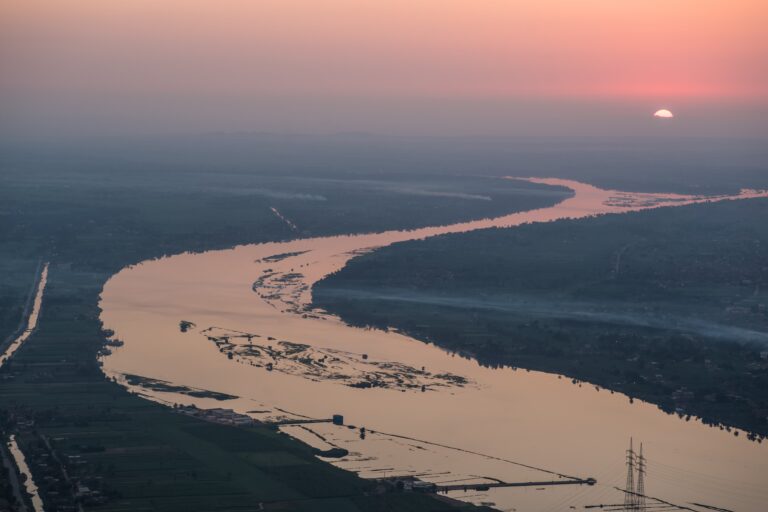When the Greek historian Herodotus wrote that the land of the ancient Egyptians was “given by the river”, he was referring to Nilewhose waters were essential to the rise of one of the world’s first great civilizations.
The Nile, which flows north 4,160 miles from east-central Africa to the Mediterranean, provided ancient Egypt with fertile soil and water for irrigation, as well as a means of transporting materials for construction projects. Its vital waters allowed cities to sprout in the middle of a desert.
In order to benefit from the benefits of the Nile, the inhabitants of its banks had to figure out how to cope with the river’s annual floods. They also developed new skills and technologies, from agriculture to boat and ship building. The Nile even played a role in the construction of the pyramids, the massive wonders that are among the most recognizable testaments to their civilization. Beyond practical matters, the vast river had a profound influence on the ancient Egyptians’ view of themselves and their world, and shaped their religion and culture.
The Nile was “a vital lifeline that literally brought life to the desert,” as Lisa Saladino Haney, assistant curator of Egypt at the Carnegie Museum of Natural History in Pittsburgh, said. writing on the museum’s website. “Without the Nile, there would be no Egypt,” the Egyptologist writes in his 2012 book: The Nile.
The Nile was a source of rich agricultural land
The modern name of the Nile comes from Nélios, the Greek word for river valley. But the ancient Egyptians called it Ar Or Aure, meaning “black”, a reference to the rich, dark sediments that the waters of the Nile carried north from the Horn of Africa and were deposited in Egypt when the river flooded its banks each year in late summer. This influx of water and nutrients transformed the Nile Valley into productive agricultural land and allowed Egyptian civilization to flourish in the middle of a desert.
The Nile Valley’s thick layer of silt “transformed what might have been a geological curiosity, a version of the Grand Canyon, into densely populated agricultural country,” explains Barry J. Kemp in Ancient Egypt: anatomy of a civilization.
The Nile was such a focal point for the ancient Egyptians that their calendar began the year with the first month of the flood. Egyptian religion even venerated a deity of the flood and fertility, Happywho was depicted as a chubby man with blue or green skin.
According to Food and Agriculture Organization of the United Nations, ancient Egyptian farmers were one of the first groups to practice large-scale agriculture, growing food crops like wheat and barley, as well as industrial crops like linen for making clothing. To make the most of the waters of the Nile, ancient Egyptian farmers developed a system called pond irrigation. They constructed networks of earthen banks to form basins and dug channels to direct floodwaters into the basins, where they would remain for a month until the soil was saturated and ready for planting.
“It is obviously a challenge if the land on which you built your house and grow your food is flooded by a river every August and September, like the Nile did before the Aswan High Dam,” explain Arthur Goldschmidt, Jr., retired professor of Middle Eastern history at Penn State University and author of A Brief History of Egypt. “Creating dikes, canals, and basins to move and store some of the Nile waters required ingenuity and probably a lot of trial-and-error experimentation for the ancient Egyptians.”
To predict whether they would face dangerous floods or low water that could lead to crop failure, the ancient Egyptians built nilometers—stone columns with marks indicating the water level.
The river served as a vital transportation route
In addition to fueling agriculture, the Nile provided a vital transportation route for the ancient Egyptians. As a result, they became skilled boat and ship builders who created both large wooden boat with sails and oarscapable of covering longer distances, and smaller skiffs in papyrus reeds attached to wooden frames.
Work of the Old Kingdomwhich existed from 2686 to 2181 BC, depicted boats carrying livestock, vegetables, fish, bread and wood. Boats were so important to the Egyptians that they buried deceased kings and dignitaries with boats sometimes so well built that they could have been used for actual Nile voyages.
The Nile Valley as an element of identity
The pyramids of Giza.
The Nile influenced how the Egyptians viewed the land they lived in, according to Haney. They divided their world into Kemet, the “black land” of the Nile Valley, where there was enough water and food for cities to thrive. In contrast, hot and dry desert areas were Deshret, the “red earth”. They associated the Nile valley and oases of desert areas with life and abundance, while deserts were associated with death and chaos.
The Nile also played an important role in the creation of monumental tombs like the Great Pyramid of Giza. An ancient papyrus diary of an official involved in the construction of the Great Pyramid describe how workers carried huge blocks of limestone on wooden boats along the Nile, then transported the blocks via a system of canals to the site where the pyramid was being built.


